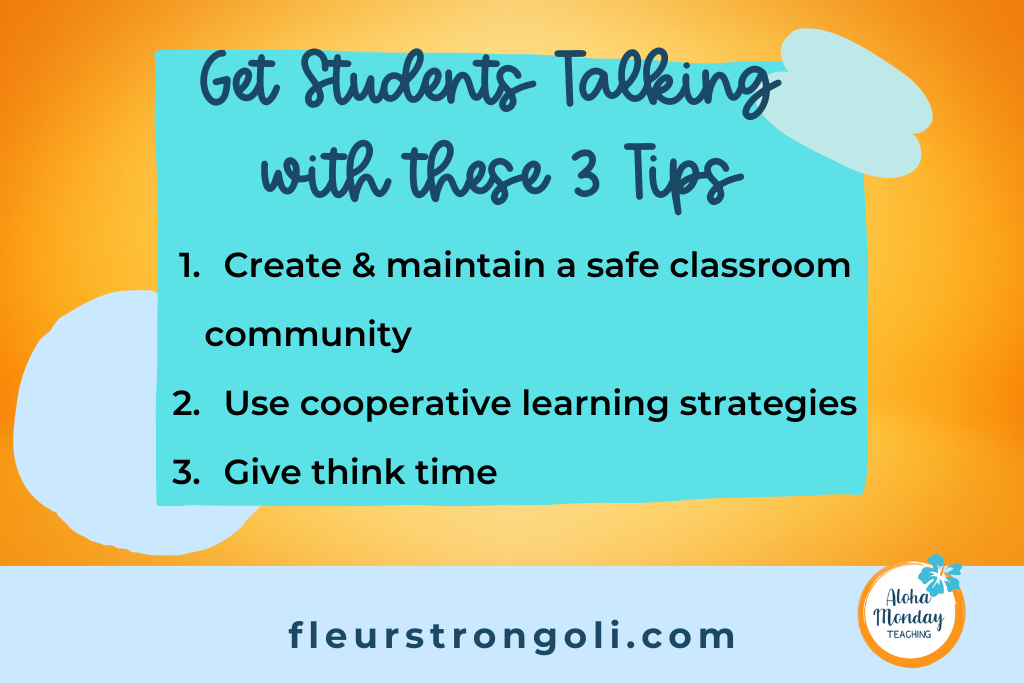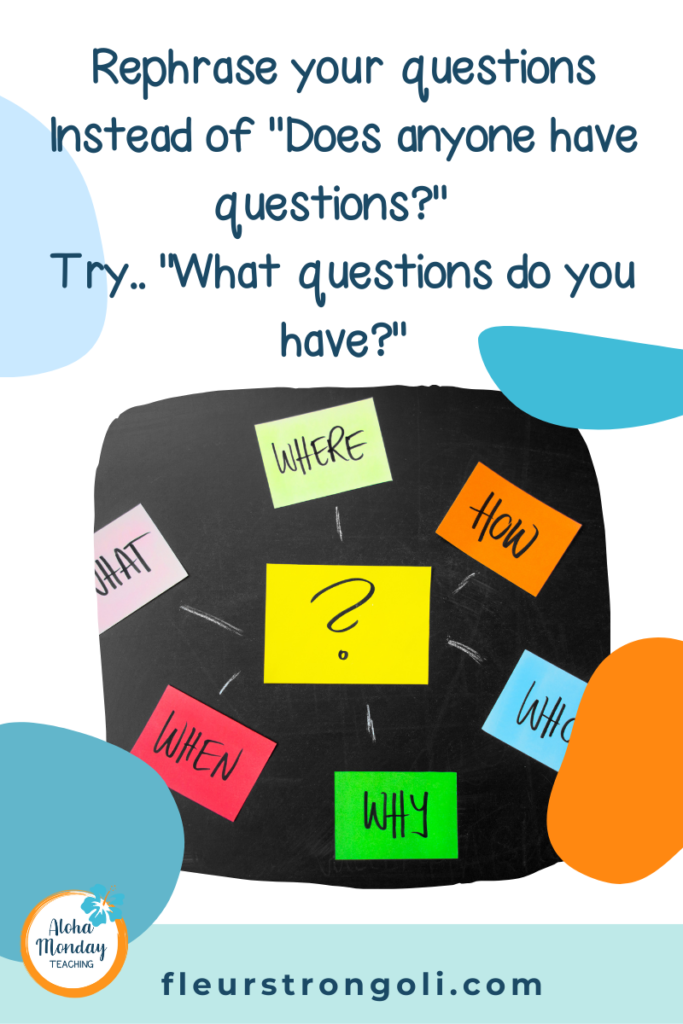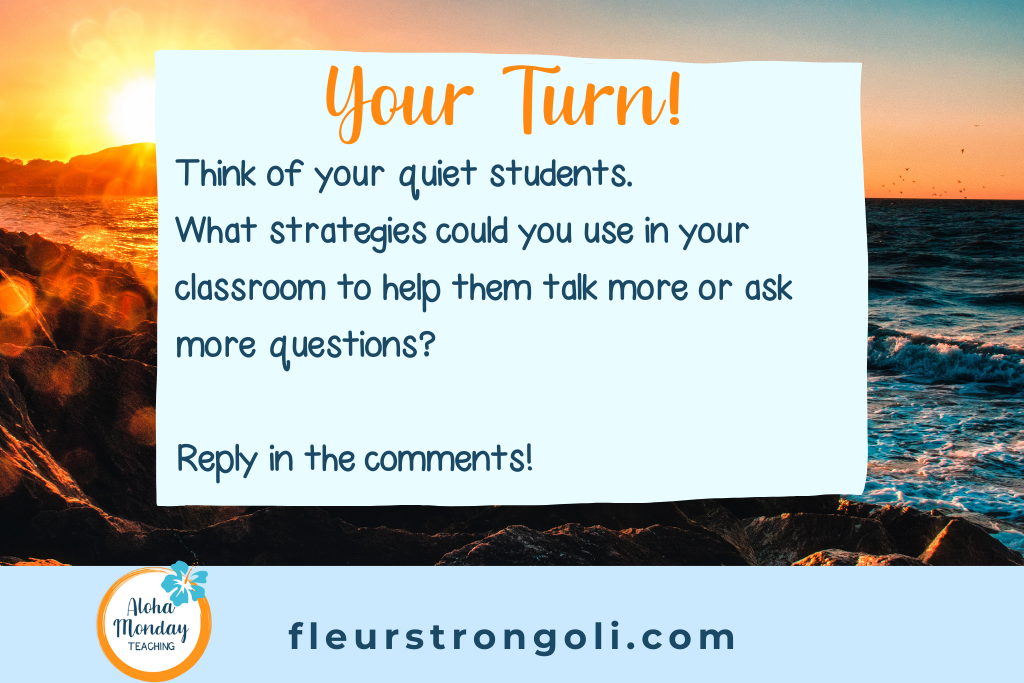3 Quick Tips on How to Get Students to Talk in Class and Increase Participation
Do you wonder how to get students to talk in class? Do you want more of your students to participate in class? Yes, having a quiet class is a nice change to the talkative classes. But how do you know if your students are learning or engaged mentally?
In those quiet, seemingly unresponsive classes, there are usually a few students you can count on to answer your questions. But what about the other students? Let’s go over ways on how to get students to talk in class so they are more engaged. And if you’re wondering what to do with the classes that talk A LOT, read this blog post or watch the video for new ideas to manage a talkative class.
In This Post
I will share some reasons why students are quiet and a few tips on how to help them talk more in class. We will go over our classroom community, cooperative learning, and think time. Then, I’ll share two ideas on how to encourage students to ask more questions in class. Doing these will increase student participation and engagement. And it will let you know that your students are learning.
Disclosure: This post contains some affiliate links for your convenience. As an Amazon Associate I earn from qualifying purchases with no cost to you.
Why is the class so quiet?
You may have a quiet class, or a class that has more quiet students who don’t volunteer to speak in front of others. So why is that? There could be a number of reasons.
The students could be tired, especially if your first class or two is quiet. The students in class could be very shy or may not feel confident enough to share their ideas. Students often worry about what others think of them. Speaking in front of the class puts all of the attention on them, and they don’t want that.
Some students suffer from anxiety, and being called on to speak feels very scary to them. And some students may not want to participate because they might be unengaged.
So with all of these different reasons for why students don’t talk in class, what do we do to help each of these students?

How to increase student talking time
Here are three quick tips to help you increase student talking time and participation in class.

Tip 1: Create and maintain a safe classroom community
From the beginning of the school year, create and maintain a classroom community that is kind and supportive. Let them know that mistakes are normal. Model that there is a way to work through mistakes to learn from them. Encourage students when they share an incorrect or partially incorrect response by saying things like, “I see what you are thinking”, or “You’re on the right track,” or “Tell us more about your thinking.” Guide them and help build their confidence.
Do team building activities to help students get to know one another. Teach them how to work together and how to have group discussions. Use brain breaks that are energizing and require interaction with their peers. In the book, Refocus and Recharge: 50 Brain Breaks for Middle Schoolers, there are a lot of energizing and calming brain breaks to choose from.
When you have a safe classroom community, students who are shy or have anxiety will feel more comfortable sharing in a small group, and perhaps with the whole class. And using energizing brain breaks will wake up those tired (pre)teens so they are ready to participate.
You can read more about building a positive classroom community in this blog post or watch this video.
Tip 2: Use Cooperative Learning Strategies
You’ve probably heard of Kagan’s Cooperative Learning in your teaching career. If you want to learn more, you must read this book. It is full of strategies to help you create a cooperative learning classroom.
One of my favorite ways to encourage students to participate and talk to each other is by seating them in groups and giving each student seat a number (1-4). I teach them how to take turns talking in their group. When I pose a discussion prompt, they take turns speaking and listening to each other. I often have someone share what someone else has said.
Using cooperative learning strategies in small groups will get every student thinking and talking. This will help those who are shy and not confident in their answers. They have opportunities to learn from each other.
Tip 3: Give Think Time
When expecting participation in a discussion or posing a question, it is important to offer think time or wait time. I’ve heard 7 seconds of wait time, but I am not sure if there really is a magic number of seconds to wait. The important thing is you are waiting to have students share.
During think time, you could have students write or sketch their idea or answer first, before sharing out loud. Some ideas I like to use are in my Brain Based Strategies PPT. Here are two examples of how I would use these when teaching about the Cell Theory.
- Sketch what Leeweunhoek possibly saw through his microscope.
- Write a one-minute summary about the discoveries that led to the Cell Theory.

After giving students time to think, have them share their ideas or answers with a partner or a group. That way, everyone gets to share. Then call on some students to share what they wrote or what was shared with them.
Remember…
Remember to make accommodations for your students with an IEP or 504. Before calling on students with IEPs or 504s to share with the whole group, you may need to tell them ahead of time if you will call on them. That will give them time to prepare a response and calm any feelings of worry before they share in front of the class.
You can read more about engaging students in this blog post or watch in this video.
How to encourage students to ask questions
Many students will ask questions, but we often wonder about our quiet ones. They don’t always ask for help or ask questions about concepts. Sometimes we don’t know they need help until it’s too late and we grade their work.
There are ways to encourage these quiet students to ask questions. Here are two strategies to try.
First, we may need to rephrase the way we ask students if they have questions. Let’s look at the common question, “Do you have any questions?” This is a yes or no type of question, and most students will jump to “No, I have no questions.”
Instead, ask something like, “What questions do you still have about the Cell Theory?” or “What do you wonder about the Cell Theory?” Rephrasing the way you question students will get them to think of ideas outside of yes or no. Then you will have more questions asked.
Another way to encourage students to ask questions is by having them write it down. Use it as an entrance or exit ticket. Give them a sticky note and have them write a question for you. You could also encourage students to email you if they are too shy to ask in class.

Wrap Up
If you have a quiet class or quiet students, we talked about a few tips on how to get students to talk in class. First, there are a variety of reasons why students may be quiet such as being shy, tired, or having anxiety. Then, I shared three quick tips to use in your classroom to encourage talking which will increase participation. Build and maintain a kind and supportive classroom community, use cooperative learning strategies, and give students think time. Finally, we talked about two ways to encourage students to ask more questions.
Your Turn
Think of your quiet students. What strategies could you use in your classroom to help them talk more or ask more questions?

Read or Watch More
Blog post: 3 Essential Components for Science Classroom Management (The first strategy is all about classroom community)
Video: How to Build a Safe and Positive Classroom Community
Blog post: I Need Help Managing a Talkative Classroom! What Should I Do?
Video: I Need Help Managing a Talkative Classroom! What Should I Do?
Blog post: 3 Important Steps to Engage Students in Lessons
Video: 3 Important Steps to Engage Students in Lessons
Book: Kagan Cooperative Learning
Book: Refocus and Recharge: 50 Brain Breaks for Middle Schoolers







